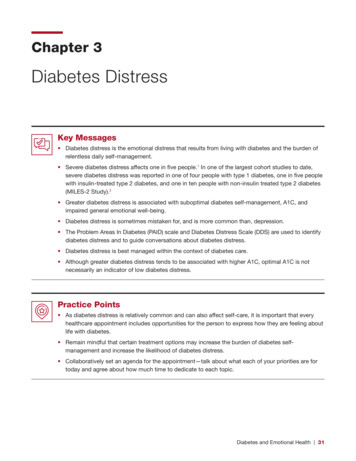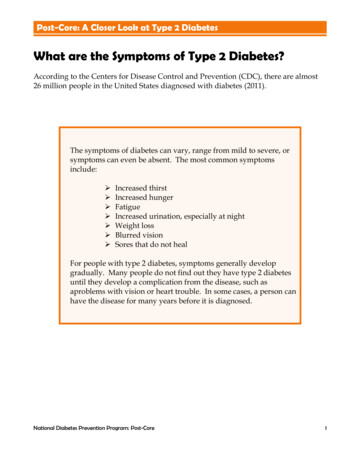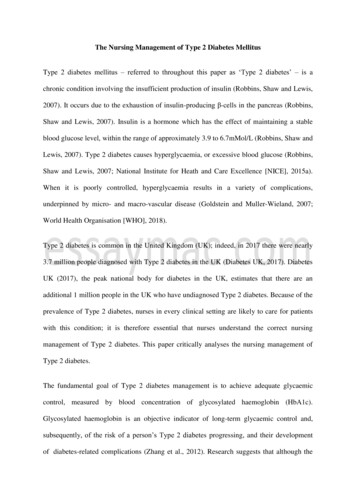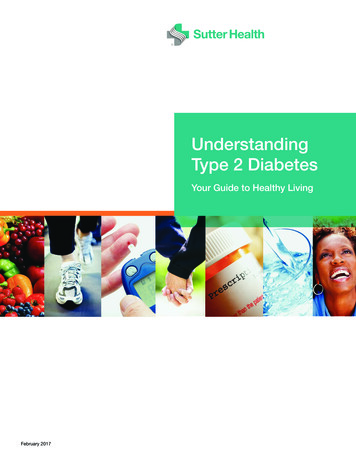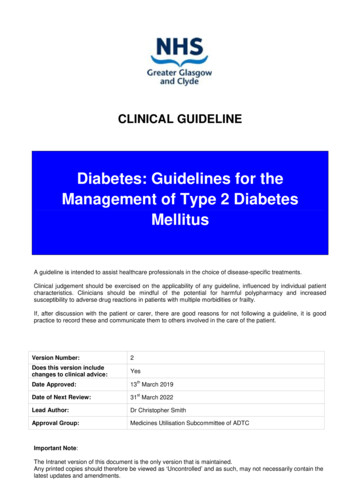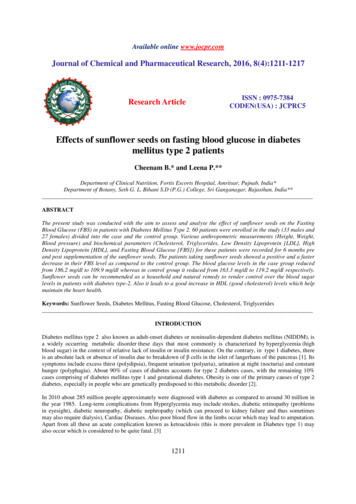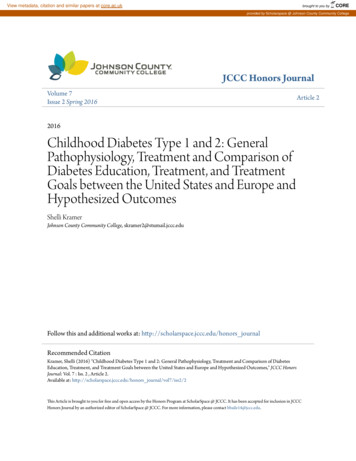
Transcription
View metadata, citation and similar papers at core.ac.ukbrought to you byCOREprovided by Scholarspace @ Johnson County Community CollegeJCCC Honors JournalVolume 7Issue 2 Spring 2016Article 22016Childhood Diabetes Type 1 and 2: GeneralPathophysiology, Treatment and Comparison ofDiabetes Education, Treatment, and TreatmentGoals between the United States and Europe andHypothesized OutcomesShelli KramerJohnson County Community College, skramer2@stumail.jccc.eduFollow this and additional works at: http://scholarspace.jccc.edu/honors journalRecommended CitationKramer, Shelli (2016) "Childhood Diabetes Type 1 and 2: General Pathophysiology, Treatment and Comparison of DiabetesEducation, Treatment, and Treatment Goals between the United States and Europe and Hypothesized Outcomes," JCCC HonorsJournal: Vol. 7 : Iss. 2 , Article 2.Available at: http://scholarspace.jccc.edu/honors journal/vol7/iss2/2This Article is brought to you for free and open access by the Honors Program at ScholarSpace @ JCCC. It has been accepted for inclusion in JCCCHonors Journal by an authorized editor of ScholarSpace @ JCCC. For more information, please contact bbaile14@jccc.edu.
Childhood Diabetes Type 1 and 2: General Pathophysiology, Treatmentand Comparison of Diabetes Education, Treatment, and Treatment Goalsbetween the United States and Europe and Hypothesized OutcomesAbstractThe goals of this paper are to bring awareness of the increasing diagnoses of diabetes in children, the resourcesavailable to help educate the diabetic child and his/her family, the importance of early treatment, diet, andcompliance with treatment, and how the education readily available, treatment, and treatment goals differbetween European nations and the United States. Multiple topics will be discussed within this paper, thepathophysiological differences between Type I Diabetes Mellitus (T1DM) and Type II Diabetes Mellitus(T2DM), the differences in the treatment methods for each, nutritional needs, challenges throughoutchildhood, and the differing outcomes for the two types of Diabetes. Also to be discussed are the differencesin how pediatric patients and their families are educated, and the educational tools that are used and readilyavailable in the United States vs. European Nations. Additionally, how the treatment plans and goals differbetween the United States and European Nations. Finally, hypothesizes will be drawn on the potential futureoutcomes of the differing Diabetic treatments and educational methods that are practiced in the United Statesand Europe.Cover Page FootnoteEllyn Mulcahy and Barb Able, Human Sciences, served as the faculty mentors for this Honors contract.This article is available in JCCC Honors Journal: http://scholarspace.jccc.edu/honors journal/vol7/iss2/2
Kramer: Childhood Diabetes Type 1 and 2IntroductionThe goals of this paper are to bring awareness of the increasing diagnoses of diabetes inchildren, the resources available to help educate the diabetic child and his/her family, theimportance of early treatment, diet, and compliance with treatment, and how the educationreadily available, treatment, and treatment goals differ between European nations and the UnitedStates. Multiple topics will be discussed within this paper, the pathophysiological differencesbetween Type I Diabetes Mellitus (T1DM) and Type II Diabetes Mellitus (T2DM), thedifferences in the treatment methods for each, nutritional needs, challenges throughoutchildhood, and the differing outcomes for the two types of Diabetes. Also to be discussed are thedifferences in how pediatric patients and their families are educated, and the educational toolsthat are used and readily available in the United States vs. European Nations. Additionally, howthe treatment plans and goals differ between the United States and European Nations. Finally,hypothesizes will be drawn on the potential future outcomes of the differing Diabetic treatmentsand educational methods that are practiced in the United States and Europe.Incident Rates of T1DM and T2DM in U.S. and European ChildrenThe prevalence of Diabetes in children living in the U.S. has been slowly and steadilyincreasing particularly in the last few decades. The most current rates of Diabetes in childrenconsist of more than 18,000 youth or approximately 78.3% of new cases per year are diagnosedwith T1DM in 2008 and 2009 in the U.S. and more than 5,000 youth or 21% of the new caseseach year (2008 and 2009) were diagnosed with T2DM (Centers for Disease Control andPrevention). Using SEARCH for Diabetes Study, a six center observational study to determinepopulation-based determination of physician-diagnosed diabetes in youth using fourPublished by ScholarSpace @ JCCC, 20161
JCCC Honors Journal, Vol. 7 [2016], Iss. 2, Art. 2geographically based centers and two health plan-based centers in the U.S. to calculate theprevalence rates of diabetes in youth based on age, gender, ethnicity, and type; it was determinedthat in 2001 the approximate prevalence of T1DM in children of all ages and ethnicity wasestimated at 1.54 per 1000 youth and approximate prevalence of T2DM in children in 2001 wasestimated at 0.22 per 1000 youth, with T1DM accounting for approximately 80% of diabeticchildren and adolescents while T2DM is only approximately 20% of the remaining diabetescases. It is important to know that the incidence of T2DM varies greatly by ethnicity with NativeAmericans being effected at a rate of approximately 0.03 per 1000 youth in the 0-9 year agegroup and a staggering rate of 1.74 per 1000 youth in the 10-19 year age group, by contrast nonHispanic whites have an incidence rate of 0.0 per 1000 youth at 0-9 year age group and 0.19 per1000 youth in the 10-19 year age group, so a big variation of prevalence of T2DM depending onage and ethnicity is seen. By comparison the estimated number of children with T1DM in the1970s ranged from 0.6 to 1.9 cases per 1000 youth including all youth under the age of 19, andthose estimates were limited geographically and looked at data almost exclusively of nonHispanic white youth and these numbers did not count for T2DM as it was rarely if everdiagnosed in youth during this time, only recently being reported in clinical studies in the lastfew decades (American Academy of Pediatrics) (Kaufman).In Europe, the incidences of both T1DM and T2DM are increasing in significantnumbers. The current studies using data from EURODIAB, a European population baseddiabetes data base and registry that tracks all information regarding diabetes across 17 Europeannations, as well as DIAMOND, a diabetes database and registry that tracks T1DM worldwide,the study groups show an average of a 3.9% yearly increase in diagnosis of T1DM across 17European Nations when examining 15 years of records (1989-2003) and noting newly diagnosedhttp://scholarspace.jccc.edu/honors journal/vol7/iss2/22
Kramer: Childhood Diabetes Type 1 and 2cases of T1DM in children under the age of 15 with the greatest percentage increase in diagnosedcases in those 5 years old or younger. The European study predicts that if the current trends ofincrease in new T1DM cases continues in addition to predicted population increases, then it isbelieved that the incidences in T1DM in the 5 and under age group will double sometimebetween 2005 and 2020. In addition, the overall increase in T1DM in all children 15 years ofage and under is predicted to increase by 70% (Patterson, Dahlquist and Gyürüs). Europe, likethe U.S., has also noted an increase in T2DM diagnoses in children the last few decades and hastaken note of the rate of increase however, though Patterson, et. al. has made note of the increaseof T2DM throughout European nations, he stresses that the increase in T2DM should notovershadow the rapid increase in T1DM diagnoses. He does acknowledge that in a fewEuropean countries T2DM may be a predominant diabetes diagnosis in pediatric patientshowever, T1DM is and will probably continue to be the predominant type of diabetes throughoutmost European countries (Patterson, Dahlquist and Gyürüs).Etiology and Pathophysiology of Type 1 and Type 2 Diabetes in ChildrenThe pathophysiology of T1DM and T2DM differ in many ways, most notably whichT1DM is considered by current research and studies to be an autoimmune disorder, while T2DMis basically thought of as an “acquired” metabolic disorder as a result of poor diet, obesity, lackof physical exercise and characterized by insulin resistance, insufficiency of the β cells in thepancreas, and an inability to properly metabolize glucose and lipids that can result inhyperglycemia. The most common type of diabetes found in children is T1DM. In T1DM,current studies and research indicates that there is an autoimmune response that causes a T-Cellmediated attack on the β cells in the islet of the pancreas resulting in the destruction of the β cellsPublished by ScholarSpace @ JCCC, 20163
JCCC Honors Journal, Vol. 7 [2016], Iss. 2, Art. 2responsible for the production of insulin leading to either no insulin production from thepancreas or insufficient insulin production leaving the body unable to regulate blood sugar levels(BSL). Most children who are diagnosed with T1DM have a prolonged asymptomatic periodwhere no illness appears to be present until such a point where the β cell destruction has reacheda point where the body can no longer regulate BSLs. At this point the children with T1DM willpresent with polyuria (excessive urination), polyphagia (excessive hunger), and weight loss. Ifthe condition is not recognized early enough with the afore mentioned symptoms thenketoacidosis, defined as the presence of ketone bodies in the urine and/or blood as the result ofthe abnormal metabolism of fatty acids and denaturing of amino acids resulting in a dangerouslylow blood pH, can occur. This is a true life or death emergent condition and if not treatedpromptly then death will soon follow. Approximately 30% of children newly diagnosed withT1DM will present in Diabetic Ketoacidosis and require hospitalization to bring glucose levelsunder control the other 70% will not require hospitalization provided adequate outpatientfacilities that are able to provide education and self-management care are accessible to the family(Janet Silverstein MD) (International Society for Pediatric and Adolecent Diabetes).Conformation of a T1DM diagnosis is the same as it is for T2DM, a fasting plasmaglucose level of 126 ml/dL which should be confirmed by a repeat test showing similar results,a A1c 6.5% using a method certified by the National Glycohemoglobin StandardizationProgram and is standardized to the Diabetes Control and Complications assay, random plasmaglucose of 200 ml/dL with symptoms of hyperglycemia, or plasma glucose level of 200ml/dL at 2hr on a Glucose Tolerance Test. Additionally, an islet autoantibody test may beperformed to detect autoantibodies in the plasma that may be responsible for the destruction ofthe β cells in the pancreas. However, it must be noted that there are T1DM individuals who arehttp://scholarspace.jccc.edu/honors journal/vol7/iss2/24
Kramer: Childhood Diabetes Type 1 and 2negative for the islet autoantibodies, in which a plasma C-peptide test may provide someguidance in diagnosis although the interpretation of the test are controversial at this time(American Diabetes Association) (Porth) (Skies) (Janet Silverstein MD) (International Societyfor Pediatric and Adolecent Diabetes).In T2DM, which used to only be diagnosed in adults usually over the age of 40, thediagnoses in children, particularly adolescents are increasing rapidly over the last two decades(Giannini). T2DM is typically considered to be an acquired disease or secondary disease causedby a metabolism disorder resulting from a poor diet that is high in carbohydrates and sugars, lackof adequate exercise, obesity, or in rare cases temporary T2DM may be brought on bypharmacological treatments for other disorders such as high doses or prolonged use of steroidsfor inflammatory or autoimmune conditions is one example, the symptomology andpathophysiological aspects of T2DM will clear up once the treatment is discontinued, or in thecase of a syndrome or disorder causing the T2DM, the T2DM will clear up once the syndrome ordisorder is properly treated or cured. Of the above mentioned factors in developing T2DM,obesity poses the highest risk. However, new studies are showing that perhaps even more of afactor than obesity itself, is how the lipids are distributed through the body. Those with higherlevels of visceral fat and/or intramyocellular lipid content are at an even higher risk of T2DMthan their peers with a similar BMI and lower levels of visceral fat and/or intramyocellular lipidcontent, as this group showed higher plasma glucose levels at 2 hr. on the Glucose test, andshowed a higher insulin resistance (Giannini) (Constantino). The diagnostic criteria for T2DM isthe same as T1DM. T2DM generally has a higher age at onset and the symptomology is similarto T1DM and includes polyuria, polydipsia (excessive thirst), weight loss, polyphagia, fatigue,Published by ScholarSpace @ JCCC, 20165
JCCC Honors Journal, Vol. 7 [2016], Iss. 2, Art. 2blurred vision, slow healing sores or frequent infections (International Society for Pediatric andAdolecent Diabetes).The pathophysiology of T2DM is complex, it basically involves first the individualbecoming resistant to the insulin that is being produced by the β cells in the pancreas and/or βcell failure. The difference between insulin resistance and β cell failure is that with insulinresistance the cells throughout the body no longer respond appropriately to the normal hormonalaction of insulin to pull glucose from the blood into the cells for utilization and storage whereas,β cell failure is due to the pancreatic β cells not producing adequate amounts of insulin to lowerthe BSL either due to exhaustion or cellular damage not due to autoimmune destruction. Thepancreatic islet β cells now work on producing even more insulin for the same levels of glucosepresent in the blood in effort to compensate for the resistance. Eventually the pancreatic β cellsare unable to compensate for the insulin resistance and hyperglycemia develops resulting inT2DM. With obesity as well as more specifically increased levels of visceral fat and/orintramyocellular lipid levels, it is the increased adipose tissues and lipids that contributes to theinsulin resistance although it is not for certain why or well understood. It is to be noted that anincrease of fat within the liver significantly increases the likelihood of developing T2DM, and asobesity rises among the youth this is becoming more and more of an issue that was typicallyreserved for adults. The studies that have been done show that while obesity, genetics, physicalactivity, and diet all play a significant role in the development of T2DM, the highest incidencesof the disorder is found in individuals whose body does not partition and store lipids in an idealmanner (Giannini). It is important to note how vital it is to differentiate whether the child hasT1DM or T2DM when diagnosing diabetes in any child, as the treatment, educationalapproaches, pathology, etiology, and outcomes will differ depending on the diagnosis. As ahttp://scholarspace.jccc.edu/honors journal/vol7/iss2/26
Kramer: Childhood Diabetes Type 1 and 2result, a child that is overweight and/or exhibits symptoms of both T1DM and T2DM it isthought that an islet autoantibody test would be useful in differentiating diagnosis of T1DM andT2DM. A plasma C-peptide level may be indicated if the child has negative autoantibody levelshowever, the readings of the measurements is a controversial issue in the medical community(Janet Silverstein MD) (International Society for Pediatric and Adolecent Diabetes) (Kaufman).Treatment for children with T1DM and T2DMTreatment for both T1DM and T2DM is multifactorial but differ in some aspects,because of the differences in the pathophysiology and etiology of the two diseases, it isimportant to be able to differentiate between whether the child has T1DM or T2DM in order toachieve the best possible long-term outcomes in treatment, quality of life, and overall health. Itis important to note that when treating both T1DM and T2DM in children and adolescents itmust be recognized that there will be additional psychological stresses on the diabetic child aswell as the parents that are not seen with non-diabetic children. These stresses revolve aroundfitting in with peers, frustration of not being able to eat whenever or whatever the child wants,fear of being excluded, and even the fear of hospitalizations. The stresses that arise withparents involve getting the child to comply with treatment, the huge responsibility of managingdiabetes, medications, diet, and multiple doctor appointments. Additionally, the parentsconstantly live with the fear of their child having to be hospitalized, suffering organ or systemdamage due to diabetes, and even the fear of knowing their child may die prematurely due tocomplications of the disease. The stresses and psychological challenges facing children withdiabetes often leads to increased rates of depression and conflicts with parents and if thesePublished by ScholarSpace @ JCCC, 20167
JCCC Honors Journal, Vol. 7 [2016], Iss. 2, Art. 2issues are not carefully addressed they can lead to lower treatment compliance which has itsown set of short term and long term consequences (Naranjo) (Janet Silverstein MD).With T1DM the diagnosed child is dependent on insulin injections or pump for infusionof insulin to control BSL in the absence of adequate pancreatic β cells to produce the necessaryinsulin. In addition, a diet that restricts refined carbohydrate intake and sugars is vitalalongside a monitored but physically active lifestyle. A healthy well rounded diet consisting ofappropriate amounts of protein, adequate vegetables and fruits, and accurate counting ofcarbohydrates is necessary to keeping the BSL well controlled and need for frequent insulinadjustments to a minimum. Working with a dietician who is experienced with diabetes andchildren as a member of the child’s Diabetes treatment team will help in managing the child’sBSLs through diet as much as possible, therefore helping to achieve the goal of optimalglycemic control as well as minimal insulin doses via Medical Nutrition Therapy. In addition,this individual can provide support and ideas for the child’s parents as taste, preferences, andmedical conditions change (Evert). The most concerning complication that can arise whentreating T1DM in children is not only the ketoacidosis, but even just as concerning ishypoglycemic attacks which if they are left unchecked or are frequent, they can result inneuropsychological impairment and difficulty in learning with younger children whose brainsare still developing rapidly (Janet Silverstein MD). The current recommendation for BSL testingis at least four times a day and even more often for younger children as determined by thechild’s physician, activity level, and dietary intake and is vital to maintaining good glycemiccontrol (American Diabetes Association) (Janet Silverstein MD) (Skies).http://scholarspace.jccc.edu/honors journal/vol7/iss2/28
Kramer: Childhood Diabetes Type 1 and 2Education for the family, parents, and the child is vitally important in managing T1DMand T2DM although the needed educational approaches differ depending on the type ofdiabetes. An important part of the education process again is dietary needs, changes, and howto meet dietary needs of children without them feeling left out or different among their peers.It is recommended in treating both T1DM and T2DM that a registered dietitian with experiencein working with children of all ages, as well as with diabetics be part of each child’s diabetic careteam to educate and support both the parents and the children in finding a realistic dietarychoices and solutions for the child and family as a whole (Evert) (Maffeis). Besides educatingthe parents and family on diet, exercise, how to perform finger sticks to check BSL,administration of insulin as well as calculating doses, and what symptoms to look for regardinghypoglycemic episodes or uncontrolled hyperglycemia in T1DM, it is just as important toeducate the child at his or her developmental level (Evert). There are a variety of methods andeducational goals for children of various developmental stages which will be discussed in a latersection of this paper.With T2DM the treatment involves much the same as T1DM, diet, exercise andmonitoring and control of BSL, as well as education (American Diabetes Association). Thecontrol of BSLs in T2DM is mainly through diet, exercise, weight loss. Since the pancreas is stillproducing adequate insulin levels in a Type II diabetic and the main issue is the body’sresistance to the insulin and β cell insufficiency, insulin therapy is not recommended except insevere cases of hyperglycemia and only as a temporary solution to reduction in BSL. However,health practitioners are beginning to prescribe Metformin or other hypoglycemicpharmaceuticals to help reduce BSLs in children. Metformin is the most commonPublished by ScholarSpace @ JCCC, 20169
JCCC Honors Journal, Vol. 7 [2016], Iss. 2, Art. 2pharmacological treatment of choice for T2DM that is normally prescribed for adults and onlyrecently began clinical trials for pediatric and adolescent patients in 2014. Physicians arebeginning to prescribe Metformin to children and adolescents whose diabetes is poorlycontrolled using diet and exercise alone in hopes of gaining better glycemic control, as theMetformin can reduce A1c levels by an average of 1.5% and the Fasting Glucose Levels by anaverage of 25% (Diabetes Mall). The main goal in the treatment of T2DM is to treat the riskfactors for the disease, namely obesity (Giannini) (American Diabetes Association). In order totreat obesity diet must be managed carefully with not just a reduced caloric intake, but achange in the foods that are consumed. The diet should become a lifestyle change and not justa diet and needs to include mostly fruits, vegetables, and small healthy proteins such as nuts,fish or lean meats while limiting carbohydrate intake and increasing fiber in the diet. Inaddition, to help with the child’s compliance with the dietary changes the child should beinvolved in choosing and preparing the foods as appropriate for his/her age and developmentlevel (Evert) (Maffeis).Just as the diet is a very important component in addressing obesity and T2DM, exerciseis also important in order to burn calories consumed, increase metabolism, and to improveuptake of glucose independent of insulin from the blood via the GLUT-4 transporters in themuscles, increases oxidative capacity, lipid oxidation and turnover, and improves glycogensynthesis which overall improves glucose metabolism. Another important aspect of increasedphysical activity in the treatment of both obesity and T2DM is that the physical activity reducesinsulin resistance over time (Giannini). It is a reasonable goal to believe that T2DM if caughtearly, and well managed through weight loss, changed lifestyle including a healthy more naturalhttp://scholarspace.jccc.edu/honors journal/vol7/iss2/210
Kramer: Childhood Diabetes Type 1 and 2diet that limits carbohydrates and packed with fruits and vegetables, regular physical exercise,and limits other risk factors such as abnormal lipid levels and hypertension, that T2DM couldactually go into remission or be cured.Comparison of Overall Long-Term Outcomes Between T1DM and T2DM CohortsRecent studies on the long-term effects of T2DM in comparison to T1DM in children andadolescence, with the study focusing on mid to late adolescence, regarding future health andmortality impacts have shown that those with T2DM tend to have more health complications inthe long term and a higher mortality rate. It was found that those diagnosed with T2DM hadsignificantly less favorable cardiac risk factors including lower HDL levels, higher serumtriglyceride levels, higher BMI, and higher BP than their T1DM cohorts. These cardiovascularrisk factors for the T2DM group was found both early in the disease, within 2-5 years ofdiagnosis, as well as later on in the disease progression (Constantino). Children and adolescencewith T2DM tend to present with abnormal albuminuria, protein in the urine, their T1DM cohortsas well as macrovascular disease with a rate of 14.4 % for the T2DM compared to 5.7% forT1DM for the same cohort group. An additional sobering find is a higher incidence of ischemicheart disease for T2DM children and adolescents at a 12.6% for T2DM children and adolescentscompared to a 2.5% for matched cohorts with T1DM and duration of diabetes were similar.Studies have found that the fatality rate for those with early onset T2DM, defined as T2DMdiagnosis in childhood or adolescence, was double compared to the fatality rate of thosediagnosed with T1DM of similar age and duration of disease. Most fatalities occurred in theprime of life and were a result of cardiovascular death. The results found in these studies giveevidence to the significantly more aggressive nature of T2DM compared to T1DM(Constantino). The studies that have been performed in comparing the long term effects ofPublished by ScholarSpace @ JCCC, 201611
JCCC Honors Journal, Vol. 7 [2016], Iss. 2, Art. 2T2DM in comparison to T1DM and the lifelong implications and outcomes expected are indeedtruly sobering, showing a very real possibility of a much lower life expectancy for thosediagnosed with T2DM and for the population as a whole as the rate of T2DM diagnosiscontinues to increase, unless some major changes are made in lifestyle and education beginningat a young age.Comparison of Treatment Goals and Patient Education for the U.S. and EuropeTreatment goals and education of patients and their family members do differ betweenthe U.S. and Europe. In the U.S. the use of insulin is only advised for T1DM and not in T2DMunless reduction of BSL is or cannot be achieved with diet and exercise. Europe does advocatethe use of insulin regardless of which type of Diabetes is diagnosed in order to bring BSL withina tight optimal window and then manage the levels within that window using diet and exercise(International Society for Pediatric and Adolecent Diabetes). In addition, Metformin isincreasingly prescribed in both countries to pediatric patients since 2000 and the rate of newMetformin prescriptions in children in general has tripled in the UK, with the highest increase ofnew prescriptions being to girls between the ages of 12-18. This may be because besidesDiabetes, Metformin is also being prescribed for Polycystic Ovarian Syndrome or PCOS as wellas for diabetes and obesity treatment. Metformin is still prescribed for younger childrenagainst manufacture’s recommendation for cases of uncontrolled diabetes though, theprescribing of Metformin in children younger than 11 has remained at a minimum showing onlya handful of children in the UK being prescribed the drug (Hsia, Dawoud and Sutcliffe)(Metformin) (Diabetes Mall). The US the incidence of Metformin prescriptions for pediatrichttp://scholarspace.jccc.edu/honors journal/vol7/iss2/212
Kramer: Childhood Diabetes Type 1 and 2patients is not specifically recorded, it is estimated that approximately 70% of the children andadolescents with T2DM in the U.S. are on Metformin, a higher rate than the United Kingdom,and approximately 30% are taking more than one hypoglycemic pharmacological treatment(Kaufman).European nations tend to stress diet, exercise, and education to help control diabetesand generally have a healthier diet and less sedentary lifestyle than their counterparts in theU.S., as demonstrated by many European nations rejecting many of the processed foods, foodadditives, and Genetically Modified Foods that are commonly consumed in the U.S. and theirlifestyle that promotes daily physical activity. Additionally, Europe has developed andimplemented the SWEET project designed to improve and raise the standards of care forchildren and youth diagnosed with diabetes. This program began by surveying families withchildren who have been diagnosed with diabetes as well as health care professionals treatingpediatric diabetics regarding all aspects of care and treatment of the disease as well ascompliance in treatment and education. The SWEET project also created centers throughoutEurope with the goal to house entire diabetic treatment teams consisting of pediatricendocrinologist, diabetic educators, diabetic specialty nurses, dieticians, and psychologist allexperienced in pediatric diabetic care to help centralize access to the professionals needed tohelp manage the care and treatment of the diabetic child and provide age appropriateeducation and services for both the parents and the children. While many centers weresuccessful at being fully staffed with recommended professionals to treat the patients in thearea, not all were adequately staffed with all of the needed professionals for example, manydid not provide a psychologist on staff to help with the emotional needs of the diabetic childPublished by ScholarSpace @ JCCC, 201613
JCCC Honors Journal, Vol. 7 [2016], Iss. 2, Art. 2and/or family members. Besides being able to have all the needed health care professionals inone building to ease the treatment and care for the patient and family, just as importantlydiabetic centers created by the SWEET project offered various educational methods andmaterials for all age groups and worked with the diabetic child in educating him or her based ontheir developmental level (Martin and Lange).Europe also employs a wide variety of creative educational methods to educate childrenabout treatment, dietary choices, injections, and a
JCCC Honors Journal Volume 7 Issue 2Spring 2016 Article 2 2016 Childhood Diabetes Type 1 and 2: General Pathophysiology, Treatment and Comparison of Diabetes Education, Treatment, and Treatment Goals between the United States and Europe and Hypothesized Outcomes Shelli Kramer Johnson County Community College, skramer2@stumail.jccc.edu

